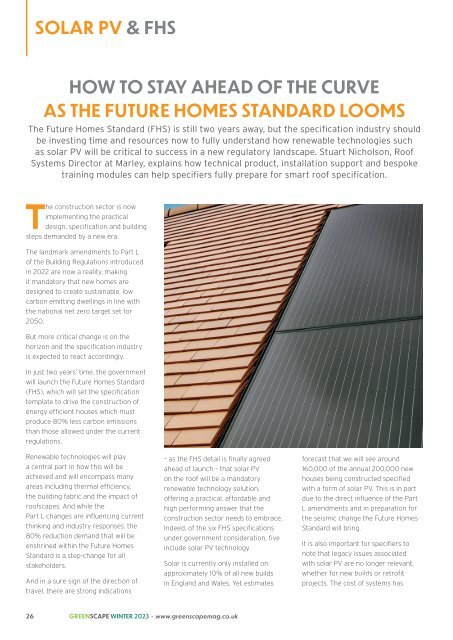Winter 2023
Create successful ePaper yourself
Turn your PDF publications into a flip-book with our unique Google optimized e-Paper software.
SOLAR PV & FHS<br />
HOW TO STAY AHEAD OF THE CURVE<br />
AS THE FUTURE HOMES STANDARD LOOMS<br />
The Future Homes Standard (FHS) is still two years away, but the specification industry should<br />
be investing time and resources now to fully understand how renewable technologies such<br />
as solar PV will be critical to success in a new regulatory landscape. Stuart Nicholson, Roof<br />
Systems Director at Marley, explains how technical product, installation support and bespoke<br />
training modules can help specifiers fully prepare for smart roof specification.<br />
The construction sector is now<br />
implementing the practical<br />
design, specification and building<br />
steps demanded by a new era.<br />
The landmark amendments to Part L<br />
of the Building Regulations introduced<br />
in 2022 are now a reality, making<br />
it mandatory that new homes are<br />
designed to create sustainable, low<br />
carbon emitting dwellings in line with<br />
the national net zero target set for<br />
2050.<br />
But more critical change is on the<br />
horizon and the specification industry<br />
is expected to react accordingly.<br />
In just two years’ time, the government<br />
will launch the Future Homes Standard<br />
(FHS), which will set the specification<br />
template to drive the construction of<br />
energy efficient houses which must<br />
produce 80% less carbon emissions<br />
than those allowed under the current<br />
regulations.<br />
Renewable technologies will play<br />
a central part in how this will be<br />
achieved and will encompass many<br />
areas including thermal efficiency,<br />
the building fabric and the impact of<br />
roofscapes. And while the<br />
Part L changes are influencing current<br />
thinking and industry responses, the<br />
80% reduction demand that will be<br />
enshrined within the Future Homes<br />
Standard is a step-change for all<br />
stakeholders.<br />
And in a sure sign of the direction of<br />
travel, there are strong indications<br />
– as the FHS detail is finally agreed<br />
ahead of launch – that solar PV<br />
on the roof will be a mandatory<br />
renewable technology solution,<br />
offering a practical, affordable and<br />
high performing answer that the<br />
construction sector needs to embrace.<br />
Indeed, of the six FHS specifications<br />
under government consideration, five<br />
include solar PV technology.<br />
Solar is currently only installed on<br />
approximately 10% of all new builds<br />
in England and Wales. Yet estimates<br />
forecast that we will see around<br />
160,000 of the annual 200,000 new<br />
houses being constructed specified<br />
with a form of solar PV. This is in part<br />
due to the direct influence of the Part<br />
L amendments and in preparation for<br />
the seismic change the Future Homes<br />
Standard will bring.<br />
It is also important for specifiers to<br />
note that legacy issues associated<br />
with solar PV are no longer relevant,<br />
Contact<br />
whether for new builds or retrofit<br />
MCS<br />
projects. The cost of systems has<br />
www.mcscertified.com<br />
26 GREENSCAPE WINTER <strong>2023</strong> • www.greenscapemag.co.uk

















